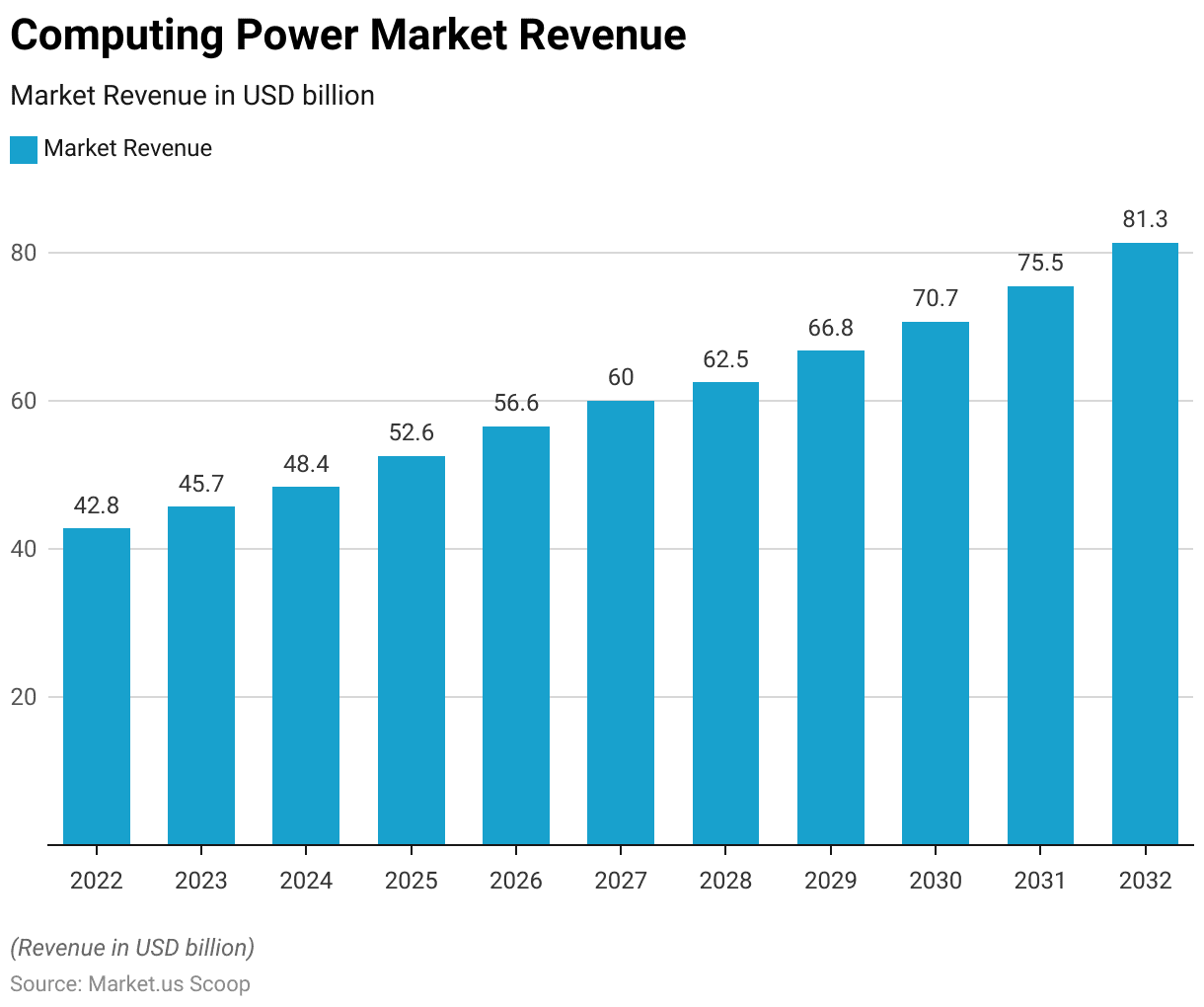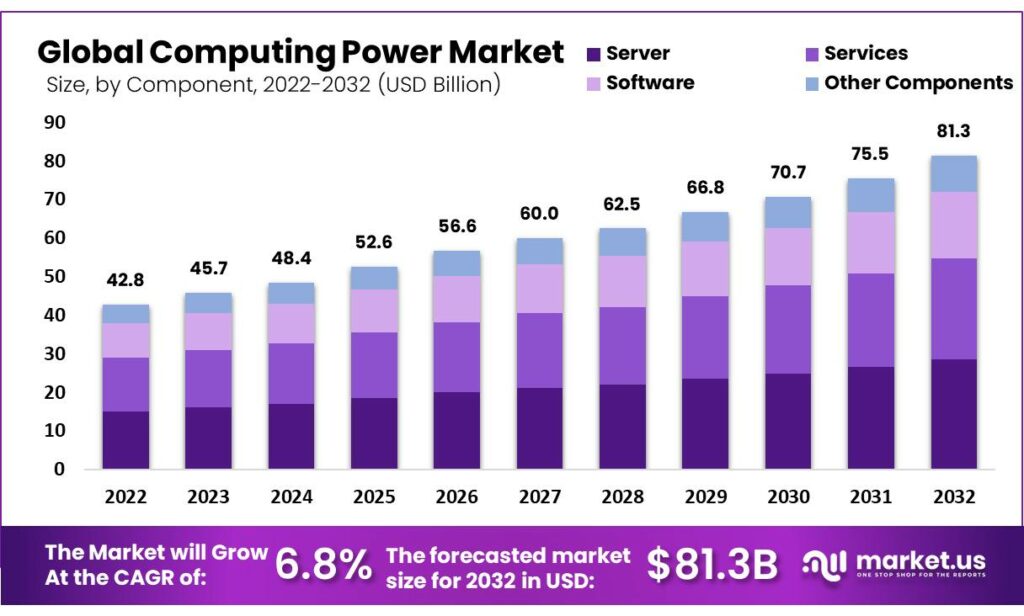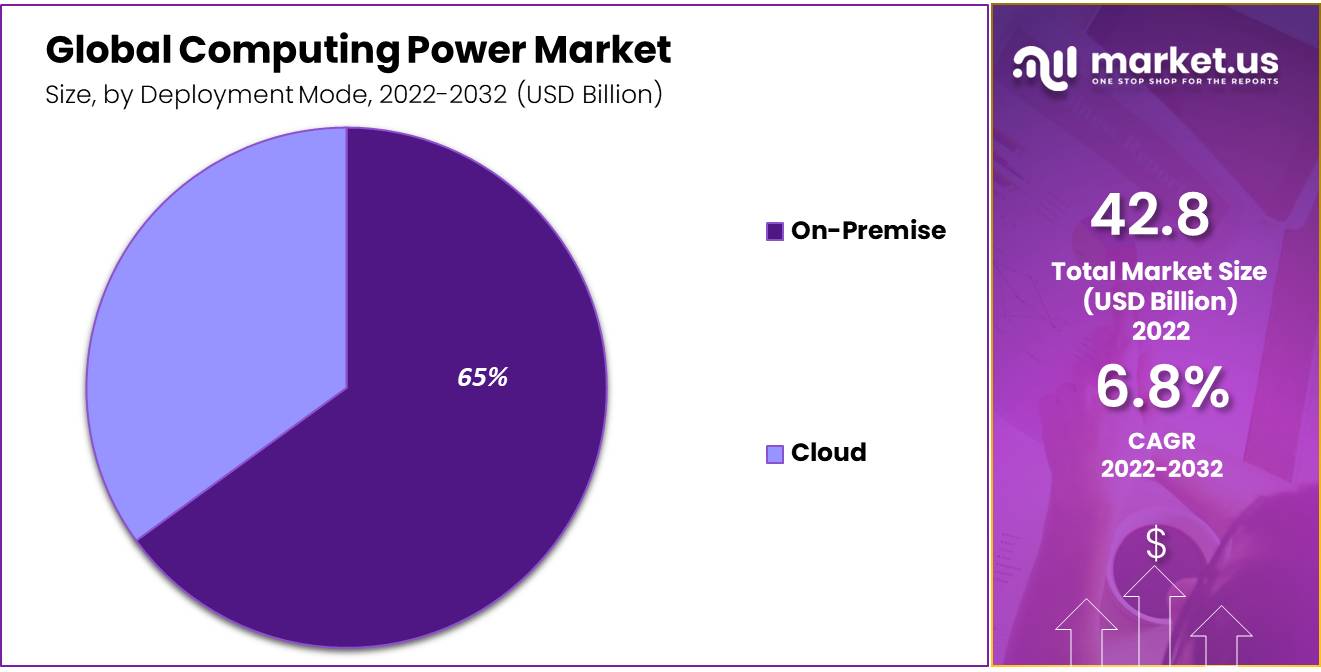Table of Contents
Introduction
According to Computing Power Statistics, Computing Power capability, which signifies a computer system’s capacity to swiftly and effectively carry out tasks, hinges on hardware elements like the CPU, GPU, memory, and storage devices. It is gauged using criteria like clock speed, the quantity of cores, and FLOPS. Factors that impact computing capability include Moore’s Law, cooling solutions, overclocking, energy efficiency, and thermal design power.
Elevated computing power has applications in areas such as scientific exploration, artificial intelligence, gaming, cryptocurrency mining, and data analysis. Upcoming trends encompass quantum computing, neuromorphic computing, edge computing, specialized hardware for AI, and energy-conscious computing. Challenges encompass physical limitations, energy consumption, safety, and accessibility concerns.
Editor’s Choice
- Over the next decade, the computing power market is poised for significant growth at a CAGR of 6.8%.
- In 2022, the market revenue stands at 42.8 billion USD, and this figure is expected to steadily rise to 81.3 billion in 2032.
- Server revenue is expected to rise from USD 15.1 billion in 2022 to USD 28.6 billion in 2032, while services revenue is forecasted to increase from USD 13.8 billion to USD 26.2 billion during the same period.
- The global computing power market exhibits a significant distribution of deployment modes, with on-premise solutions dominating the landscape with a substantial market share of 65%.
- Windows PCs usually employ the 32-bit x86 architecture, Apple utilizes PowerPC chips, which can be 64 or 128-bit, providing them with a performance edge despite lower clock speeds.
- Most computers today use standard PC100 RAM, which operates at 100MHz, suitable for most applications.
- Nowadays, most hard drives spin at 7,200 RPMs, while older models and laptops typically spin at 5,200 RPMs.
Computing Power Market Overview
Global Computing Power Market Size
- Over the next decade, the computing power market is poised for significant growth at a CAGR of 6.8%, as indicated by the projected revenues in billions of USD.
- In 2022, the market revenue stands at 42.8 billion USD, and this figure is expected to steadily rise in the coming years.
- By 2023, it is estimated to reach 45.7 billion USD, followed by 48.4 billion USD in 2024 and 52.6 billion USD in 2025.
- Finally, in 2032, the market is expected to reach an impressive 81.3 billion USD in revenue.

Global Computing Power Market Size – By Component
- The global computing power market is expected to experience steady growth over the next decade.
- In 2022, the total market revenue reached USD 42.8 billion, with servers contributing USD 15.1 billion, services generating USD 13.8 billion, software accounting for USD 9.0 billion, and other components contributing USD 4.9 billion to the market.
- Server revenue is expected to rise from USD 15.1 billion in 2022 to USD 28.6 billion in 2032, while services revenue is forecasted to increase from USD 13.8 billion to USD 26.2 billion during the same period.
- Software revenue will also see significant growth, reaching USD 17.2 billion in 2032, and other components revenue is expected to reach USD 9.4 billion.

Computing Power Market Share – By Deployment Mode
- The global computing power market exhibits a significant distribution of deployment modes, with on-premise solutions dominating the landscape with a substantial market share of 65%.
- On the other hand, cloud-based solutions account for the remaining 35% of the market share. This division underscores the diverse preferences and requirements of businesses and organizations when it comes to their computing power infrastructure.
- On-premise solutions continue to be favored by many enterprises that prioritize having full control over their hardware and data security.

Historical Trends in Computing Power
- In December 1945, ENIAC, the first electronic general-purpose computer, conducted hydrogen bomb calculations at the University of Pennsylvania’s Moore School of Electrical Engineering under a U.S. Army contract.
- In April 1964, IBM introduced the System 360 computer family, streamlining upgrades with a shared instruction set.
- In 1971, Bob Thomas at BBN created the initial computer virus, called Creeper, which replicated itself on ARPANET-linked computers and displayed the message “I’m the creeper, catch me if you can!”
- In 1981, Apollo Computer introduced the first graphics workstation using the Motorola 68000 microprocessor, later joined by competitors Sun Microsystems and Silicon Graphics.
- In May 1995, Sun launched Java, a programming language aimed at enabling cross-platform compatibility. It gained popularity when Netscape used it for web page animation and interactivity.
- In October 2012, a convolutional neural network created by University of Toronto researchers achieved a remarkable 16% error rate in the ImageNet Large Scale Visual Recognition Challenge, improving upon the previous year’s 25% rate.
- Finally, in July 2020, OpenAI introduced GPT-3, which, powered by 175 billion machine learning parameters, generates text that resembles human language.
Factors Affecting Computing Power
Processor Speed
- Processor speed, often referred to as clock speed, is sometimes overstated as the primary driver of a computer’s performance. While it does matter for tasks like video encoding and complex calculations, the average user rarely pushes their CPU to its limits.
- During everyday activities like typing, email, or web browsing, the CPU typically runs at just 1 or 2 percent of its maximum speed. The CPU encounters significant demands primarily during startup, often hampered by hard drive speed.
- Megahertz (MHz) or Gigahertz (GHz) indicates how rapidly the CPU toggles between 1 and 0, influencing its processing power when all else is equal.
- Higher MHz chips consume more power and generate more heat. Level 1 (L1) and Level 2 (L2) cache are swift on-chip memory used to briefly store data before and after processing.
- SRAM, specific to processors, is costly; nowadays, most chips feature 128KB of L1 cache and 256-512KB of L2 cache.
System RAM Speed and Size
- The quantity and speed of your computer’s RAM have a significant impact on its performance. If you attempt to run Windows XP with just 64 MB of RAM, it’s likely to struggle or even fail.
- When the available RAM is fully utilized, the computer must resort to using the slower hard drive to cache data. This constant back-and-forth data transfer between RAM and virtual memory (hard drive) considerably slows down the computer, especially when loading applications or files.
- There are two types of RAM, primarily dynamic RAM, which is more common. Dynamic RAM requires frequent refreshing thousands of times per second.
- On the other hand, static RAM doesn’t need refreshing, making it faster but also more expensive. Both types of RAM are volatile, meaning they lose their data when the power is turned off.
Disk Speed and Size (RPMs and Gigabytes)
- The speed of your computer’s hard disk is the most significant factor affecting its performance.
- The hard drive’s ability to quickly locate data (average seek time), read, write, and transfer data has a substantial impact on how your computer operates.
- Nowadays, most hard drives spin at 7,200 RPMs, while older models and laptops typically spin at 5,200 RPMs, which is one reason why laptops may seem slower compared to desktop computers.
Video Card
- In a typical desktop computer, you’ll find a mid-range video card with 32 to 64 megabytes of video memory, while an average laptop usually has a basic onboard graphics chip with 16 megabytes of memory.
- When your computer displays an image on the screen, it requires a rendering process. If the computer relies on software for this task, it tends to be slower and can adversely affect overall performance.
- Additionally, the displayed images may lack crispness and smoothness, especially in the case of video playback. Even a modest video card can substantially enhance computer performance by offloading the demanding task of rendering images from the CPU to the graphics card.
Temperature
- The most common threat to your processor is overheating, which occurs as the CPU takes on more tasks, causing it to heat up.
- High temperatures can harm its performance and potentially shorten its lifespan.
- To prevent overheating, modern processors are designed to operate safely at temperatures up to 176 degrees Fahrenheit (80 degrees Celsius), and some newer Intel and AMD CPUs can handle even higher temperatures, up to 194F/90C.
Challenges in Computing Power
- The era of digitalization is witnessing an unprecedented surge in applications, connections, devices, users, and the volume of generated data. This surge demands vast computational capabilities.
- For instance, the computing power needed for artificial intelligence is doubling every 100 days and is projected to increase by over a million times in the next 5 years.
Discuss your needs with our analyst
Please share your requirements with more details so our analyst can check if they can solve your problem(s)



